
Football hooliganism, also known as soccer hooliganism, football rioting or soccer rioting constitutes violence and other destructive behaviors perpetrated by spectators at association football events. Football hooliganism typically involves conflict between pseudo-tribes, formed to intimidate and attack supporters of other teams. Certain clubs have long-standing rivalries with other clubs and hooliganism associated with matches between them can be more severe. An example of this is the Devon Derby . Conflict may arise at any point, before, during or after matches and occasionally outside of game situations. Participants often select locations away from stadiums to avoid arrest by the police, but conflict can also erupt spontaneously inside the stadium or in the surrounding streets. In extreme cases, hooligans, police and bystanders have been killed, and riot police have intervened. Hooligan-led violence has been called "aggro" and "bovver".

Nogometni klub Inter Zaprešić was a Croatian professional football club based in Zaprešić, a town northwest of the capital Zagreb.

Eternal Derby also known as the Croatian Derby, is the name given to matches between the two biggest and most popular Croatian football clubs Dinamo Zagreb and Hajduk Split.

Damir Krznar is a Croatian professional football manager and former player who is the manager of Slovenian PrvaLiga club Celje.

Ognjen Vukojević is a Croatian football manager and former professional player. He is currently the manager of the Croatia national under-20 team, an assistant manager of Ukrainian Premier League club Dynamo Kyiv, and a scout of the Croatia national team.

Domagoj Vida is a Croatian professional footballer who plays as a defender for Super League Greece club AEK Athens and the Croatia national team. He is capable of playing in any defensive position but is mostly deployed as a centre-back.

Zdravko Mamić is a Croatian-Bosnian former football administrator and sports agent. From 2003 to 2016, he was the executive director of Croatian football club GNK Dinamo Zagreb.
GNK Dinamo Zagreb are an association football club from Zagreb, Croatia. Home matches were played at the club's ground, Maksimir Stadium. Dinamo's season officially began 1 June 2010 and concluded on 30 May 2011, although competitive matches were played between 13 July and 25 May. During the season they competed in the Prva HNL, the highest division in Croatian football, and the Croatian Cup. They also played a total of twelve European games, first in the preliminary stages of the 2010–11 UEFA Champions League and later in the 2010–11 UEFA Europa League.

Građanski nogometni klub Dinamo Zagreb, commonly referred to as GNK Dinamo Zagreb or simply Dinamo Zagreb, is a Croatian professional football club based in Zagreb. Dinamo play their home matches at Stadion Maksimir. They are the most successful club in Croatian football, having won twenty-four Prva HNL titles, sixteen Croatian Cups, еight Croatian Super Cups, and one Inter-Cities Fairs Cup. The club has spent its entire existence in top flight, having been members of the Yugoslav First League from 1946 to 1991, and then the Prva HNL since its foundation in 1993.
Petar Mamić is a Croatian professional footballer who plays as a left-back for Liga I club CFR Cluj.

Željko Kopić is a Croatian football manager and former player who is the current head coach of Liga I club Dinamo București.
Vinko Soldo is a Croatian football player who plays as centre-back for Bosnian Premier League club Sarajevo.
Petar Bočkaj is a Croatian footballer who plays as a left-back or winger for Cypriot club Pafos, on loan from Dinamo Zagreb.
Lirim M. Kastrati is a Kosovan professional footballer who plays as a winger for Croatian club Lokomotiva on loan from Fehérvár, and the Kosovo national team.
This page is containing records and statistics of Croatian football club GNK Dinamo Zagreb. It shows club records as well as individual records achieved by the club's players.
The 2020–21 GNK Dinamo Zagreb season was the club's 110th season in existence and its 30th consecutive season in the top flight of Croatian football. In addition to the domestic league, Dinamo Zagreb participated in this season's editions of the Croatian Football Cup, the UEFA Champions League, and the UEFA Europa League. The season covered the period from 26 July 2020 to 30 June 2021.
Osijek–Rijeka derby is the name given to matches between NK Osijek and HNK Rijeka. On Croatian First Football League all time table Rijeka and Osijek are on the third and fourth place. Rijeka is the third-most successful Croatian football club, having won one Croatian First Football League title, six Croatian Football Cups, two Yugoslav Cups, one Croatian Football Super Cup and the 1977–78 Balkans Cup. Osijek won one Croatian Football Cup.
The 2023–24 season is GNK Dinamo Zagreb's 113th season in existence and 12th consecutive in the Croatian Football League. They are also competing in the Croatian Cup, the Croatian Super Cup, the UEFA Champions League, the UEFA Europa League and the UEFA Europa Conference League.
Michalis Katsouris was murdered during hooligan riots between a joint coalition of Bad Blue Boys of Dinamo Zagreb and Gate 13 of Panathinaikos who engaged in conflict with AEK Athens supporters.










